Let's face it – compared to Mars, our planet is a biological paradise dripping with moisture and relative absence of toxic chemistry. If we want to know what life might look like on the Red Planet, we need to go hunting in extreme environments.
Ethiopia's Dallol geothermal area could qualify. Minerals from one of the volcano's many hot, acidic, salty springs have been found to contain an ultra-tiny order of microbe, a discovery that helps establish the limits of living chemistry.
An international team of researchers collected samples from a hydrothermal pool in the Danakil Depression – a desolate landscape 125 metres (410 feet) below sea level that ranks as one of the hottest places on the planet's surface – and analysed them for signs of life.
The depression is a fascinating place. It was once a marine environment, but the separation of several tectonic plates has since warped the crust and turned the sea into a salt plain.
Tectonic movements have also turned it into a hot mess of volcanoes, mineral deposits, and acidic springs: an extreme environment that only appeared early last century.
High heat, salt, and an insanely low pH aren't typical conditions you'd expect to harbour life. But if we've learned one thing in recent decades, it's to never underestimate life's ability to cope with adversity.
Just how adverse, though, is the question. There are plenty of examples of extremophile microbes living in all kinds of insanely hot habitats, dealing with the corrosive effects of acids or the desiccating impact of salts.
Any one of those environments would test the talents of even the hardiest cells.
To survive in the Dallol volcano's hot springs, with a highly acidic pH of around 0.25, temperatures reaching 90 degrees Celsius (194° F), and surroundings brimming with heavy metals and salts, life would truly need to be gifted.
Given nobody had yet ruled out any sort of life making its home there, the researchers collected hydrothermal fluids and crunched up salt precipitates left by liquid bubbling from hot springs, and searched them for familiar DNA sequences.
They also filtered the material and hunted with a microscope for visual signs of living cells.
Sure enough, they found evidence of an order of nano-sized, salt tolerant microbes belonging to the archaea domain of life. Or Nanohaloarchaea if you prefer an official term.
"This is an exotic, multi-extreme environment, with organisms that need to love high temperature, high salt content and very low pH in order to survive," says microbiologist Felipe Gómez from the Astrobiology Center in Spain.
At somewhere between 50 and 500 nanometres across, the small, spherical cells rival the smallest possible living things that can self-reproduce, putting them at the current size limit of what we can expect from any living thing.
These borderlands of life of Earth can tell us a lot about what we might expect of life on other worlds.
Mars is constantly teasing us with possibility of a historical or even presently active biosphere. The planet wouldn't make existence easy, being far drier than any place on Earth and awash with toxic compounds called perchlorates that would make short work of just about any known species.
By comparison, even waterless places like the Atacama Desert in Chile and horridly toxic ponds like Dallol springs seem like holiday camps.
But their tiny residents could harbour at least a few secrets that tell us how life might persist in ever-harsher environments. Further research would reveal the tricks of their trade and expand our understanding of how biochemistry operates under stress.
"Deep investigation of the characteristics of this amazing site will improve our understanding of the limits of life on Earth and inform our search for life on Mars and elsewhere in the Universe," says Barbara Cavalazzi from the University of Bologna.
There's no knowing what kind of basic biochemistry might make up life endemic to our nearest neighbour, let alone whether it mirrors our own.
But looking at the worst places on Earth might at least give us a hint of what life could be like in environments that radically differ from the majority of our highly hospitable planet.
This research was published in Scientific Reports.
